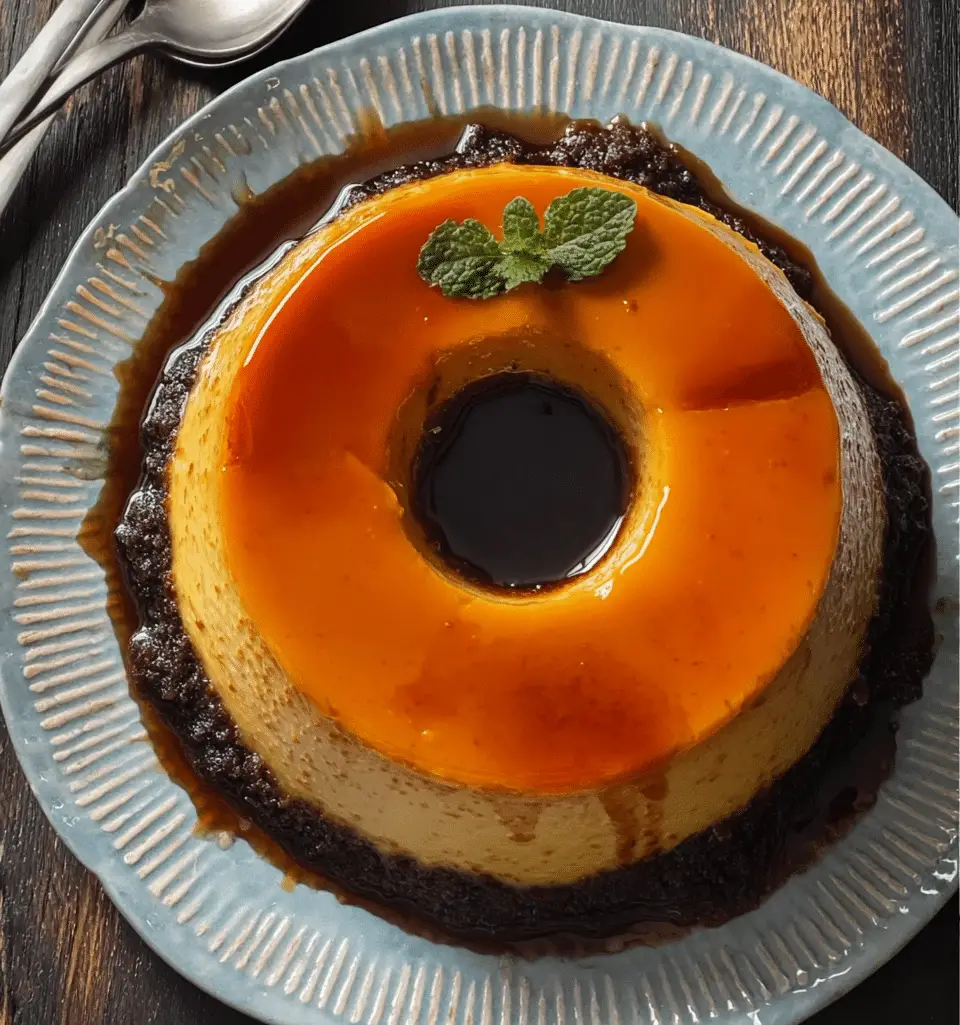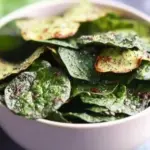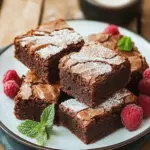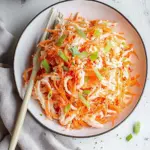The flancocho is a Puerto Rican culinary gem that brings together two beloved desserts into one unforgettable treat. Creamy flan and moist chocolate cake are layered with precision, baked in a caramel-lined Bundt pan to create a stunning dessert with rich flavor and dramatic presentation.
Whether you’re celebrating a holiday, hosting a special gathering, or simply satisfying a sweet craving, this chocoflan will wow your guests with both taste and looks. Its magical flip—where flan rises above the cake after baking—is always a delightful surprise that’s sure to spark conversation around the table.
Full Recipe
Ingredients:
For the Caramel Base:
-
1 cup white sugar
For the Flan Layer:
-
1 can (14 oz) sweetened condensed milk
-
1 can (12 oz) evaporated milk
-
4 large eggs
-
1 tsp vanilla extract
For the Chocolate Cake Layer:
-
1/2 cup unsalted butter, softened
-
3/4 cup white sugar
-
2 eggs
-
1 tsp vanilla extract
-
1 cup all-purpose flour
-
1/3 cup cocoa powder
-
1 tsp baking powder
-
1/2 tsp baking soda
-
1/4 tsp salt
-
1/2 cup whole milk
Directions:
-
Preheat the oven to 350°F (175°C). Grease a 10-inch Bundt pan generously.
-
In a dry saucepan over medium heat, melt the sugar for the caramel, swirling the pan occasionally until fully melted and golden. Immediately pour into the prepared Bundt pan, tilting to coat the bottom evenly. Let it cool and harden.
-
In a blender, combine sweetened condensed milk, evaporated milk, eggs, and vanilla extract. Blend until smooth. Set aside.
-
In a mixing bowl, cream the butter and sugar until light and fluffy. Add the eggs one at a time, then stir in vanilla.
-
In a separate bowl, whisk together the flour, cocoa powder, baking powder, baking soda, and salt.
-
Gradually add the dry ingredients into the butter mixture, alternating with milk. Mix until well combined.
-
Pour the chocolate cake batter over the cooled caramel in the Bundt pan.
-
Slowly pour the flan mixture over the cake batter. The flan will sink beneath the cake layer as it bakes.
-
Cover the pan with foil. Place it inside a larger baking dish filled halfway with hot water (bain-marie).
-
Bake for 60–70 minutes or until a toothpick inserted into the cake comes out clean.
-
Remove from water bath and let cool to room temperature, then refrigerate for at least 4 hours or overnight.
-
Invert onto a serving plate and let the caramel glaze the flancocho.
Prep Time: 20 minutes | Cooking Time: 70 minutes | Total Time: 90 minutes
Kcal: 410 kcal | Servings: 10 servings
Introduction to Puerto Rican Flancocho (Chocoflan)
Puerto Rican Flancocho, also known as Chocoflan, is a luxurious, visually stunning dessert that showcases the beauty of combining two beloved Latin sweets: creamy caramel flan and rich chocolate cake. This dessert is famous not only for its delicious dual texture and flavor but also for the magical process that happens in the oven — the layers switch positions during baking, with the flan rising to the top and the chocolate cake settling at the bottom. The result is a beautifully inverted cake, topped with a shimmering layer of caramel.
Flancocho is especially popular during holidays, birthdays, and family celebrations in Puerto Rico, and it has become a staple in many Latin American households due to its blend of tradition, elegance, and irresistible flavor. Whether you’re familiar with Latin desserts or exploring them for the first time, flancocho delivers a rich cultural experience through taste and presentation.
Cultural Significance of Flancocho
In Puerto Rican cuisine, desserts are more than just a sweet ending — they’re a key part of tradition and community. Flancocho exemplifies this spirit. It brings people together, whether at family dinners, Christmas celebrations, or Sunday get-togethers. The act of preparing it often involves more than one person, and the final presentation is almost ceremonial when it’s flipped onto a serving dish, revealing that beautiful caramel glaze.
The recipe showcases the influence of Spanish and Afro-Caribbean culinary heritage, where flan was a prominent dessert brought over by Spanish colonizers, and baking traditions merged with local ingredients and techniques. Over time, the fusion of flan with a moist chocolate cake layer — often made from scratch — became a uniquely Puerto Rican expression of celebration.
What Makes Flancocho Unique
One of the most remarkable aspects of flancocho is its physics-defying baking process. The heavier flan mixture, poured over the lighter chocolate cake batter, defies expectations by rising to the top during baking. This natural separation creates two distinct but harmonious layers: the silky, custard-like flan and the soft, dense cake.
Another standout feature is the caramel layer that coats the entire dessert. As it bakes and later cools in the fridge, the caramel sets and becomes a glossy glaze that drapes over the flan when unmolded. It adds a sweet, slightly bitter contrast to the richness of the flan and cake.
In terms of taste and texture, flancocho hits every note: velvety, moist, sweet, and slightly bitter. Its balance is impeccable, making it feel indulgent yet never overwhelming.
Variations Across Latin America
While flancocho is most closely associated with Puerto Rico, similar versions exist throughout Latin America. In Mexico, “chocoflan” is made with a box cake mix and known as “the impossible cake” due to the way the layers invert themselves. However, Puerto Rican flancocho is often made entirely from scratch, using traditional baking methods and a Bundt pan, adding an extra touch of homemade authenticity.
Other variations include flavoring the flan with coconut milk, cream cheese, or even rum for added complexity. The cake layer can also be customized with espresso powder, cinnamon, or even chili for a spiced twist. These regional adaptations allow flancocho to evolve and reflect local tastes, while still honoring its classic foundation.
Why It’s a Crowd Favorite
There’s no denying that flancocho has the “wow” factor. Whether you’re serving it at a formal dinner party or a casual family barbecue, it never fails to impress. The dual-layer presentation looks as if it required hours of expert technique — even though it’s surprisingly easy to make if you follow the right steps.
The contrast in textures makes it universally appealing: the softness of the cake against the silky flan creates a mouthfeel that feels both luxurious and comforting. Plus, the caramel ties everything together with a slightly burnt, syrupy sweetness that lingers on the palate.
Not only is flancocho delicious, but it’s also a conversation starter. Many guests are curious about how the layers switch in the oven, and that bit of baking “magic” adds to the overall enjoyment of the dish.
Tips for Perfect Flancocho Every Time
While the recipe is fairly straightforward, a few expert tips can help ensure success:
-
Use room-temperature ingredients. This helps the batter and flan blend evenly without lumps or temperature shock.
-
Grease your Bundt pan thoroughly. A nonstick spray with flour or butter and sugar coating helps release the dessert cleanly when flipped.
-
Bake in a water bath. Also known as a bain-marie, this method keeps the custard smooth and prevents the cake from overbaking.
-
Refrigerate for several hours (or overnight). This allows the caramel to firm up and makes unmolding easier and cleaner.
-
Invert with confidence. After a good chill, use a plate with a lip to catch any excess caramel, and flip swiftly in one motion.
Serving Suggestions
Flancocho is best served chilled, making it ideal for warm weather occasions or after a rich, savory meal. Garnish is optional — the caramel topping does most of the visual work — but you can add fresh berries, mint leaves, a dusting of powdered sugar, or even a dollop of whipped cream for extra flair.
It pairs well with espresso, coffee, or dessert wine, and if you’re serving it at a party, consider slicing it tableside to show off the beautiful layers and creamy texture.
Storage and Make-Ahead Tips
One of the best things about flancocho is that it stores beautifully. It can be made a day or two in advance, which is perfect for busy hosts or when preparing for a large gathering.
Keep it refrigerated in the Bundt pan until you’re ready to serve. Once unmolded, leftovers should be stored in an airtight container in the fridge and will stay fresh for up to five days.
Nutritional Profile
Flancocho is undoubtedly a treat, but it’s also incredibly satisfying. A single serving provides a balanced bite of protein from the eggs and dairy, fats from the butter, and carbohydrates from the sugar and flour. While not low-calorie, it’s the kind of dessert where a small slice goes a long way, thanks to its richness and depth of flavor.
A Dessert with Heart and History
Part of what makes flancocho so special is the emotion it carries. It’s a dessert handed down through generations — grandmothers teaching their daughters, who then pass it on to their children. Each family might tweak the recipe slightly, adding their own special touches, but the core elements remain the same. That continuity makes it a culinary time capsule, connecting generations through taste and tradition.
Conclusion
Puerto Rican flancocho is more than just a dessert — it’s a celebration of culture, creativity, and the simple joy of sharing food with the people you love. Its rich, moist chocolate cake paired with silky, vanilla flan and golden caramel is an irresistible trio that delights the senses.
Whether you’re making it for a holiday, a birthday, or simply to treat yourself, flancocho brings a touch of magic to the table. Its layers tell a story, not just of baking technique, but of cultural fusion and heartfelt tradition. Once you’ve had a slice, you’ll understand why this dessert holds such a cherished place in Puerto Rican cuisine — and why it’s quickly winning hearts around the world.






